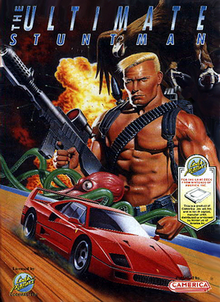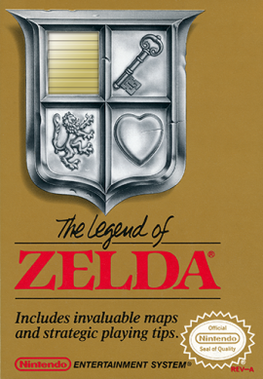
The Legend of Zelda, originally released in Japan as The Hyrule Fantasy: Zelda no Densetsu, is a 1986 action-adventure game developed and published by Nintendo. The first game of The Legend of Zelda series, it is set in the fantasy land of Hyrule and centers on an elf-like boy named Link, who aims to collect the eight fragments of the Triforce of Wisdom in order to rescue Princess Zelda from the antagonist Ganon. During the course of the game, the player controls Link from a top-down perspective and navigates throughout the overworld and dungeons, collecting weapons, defeating enemies and uncovering secrets along the way.

The Aladdin Deck Enhancer is a system-enhancing adaptor to use Compact Cartridges on the Nintendo Entertainment System. It was produced by Camerica and developed by Codemasters but not licensed by Nintendo. It is similar to the Datach system for the Famicom, but without the Barcode feature. It was released in November 1992, with its planned library to reach a total 24 games by the end of 1993. However, only seven games were actually released.

Treasure Island Dizzy is a puzzle video game published in 1989 by Codemasters for the Amstrad CPC and ZX Spectrum, and later ported to the Commodore 64, NES, Amiga, Atari ST and Atari Jaguar.
Game Genie is a line of video game cheat cartridges originally designed by Codemasters, sold by Camerica and Galoob. The first device in the series was released in 1990 for the Nintendo Entertainment System, with subsequent devices released for the Super NES, Game Boy, Genesis, and Game Gear. All Game Genie devices temporarily modify game data, allowing the player to do things unintended by developers such as, depending on the game, cheating, manipulating various aspects of games, and accessing unused assets and functions. Five million units of the original Game Genie products were sold worldwide, and most video game console emulators feature Game Genie code support. Emulators that have Game Genie support also allow a near-unlimited number of codes to be entered whereas the actual products have an upper and lower limit, between three and six codes.

Action 52 is an unlicensed, multicart video game compilation developed by Active Enterprises for the Nintendo Entertainment System, and by FarSight Technologies for the Sega Genesis. The NES version was released in 1991, followed by the Genesis version in 1993. The multicart consists of 52 games in a variety of genres, mostly scrolling shooters and platformers. The "featured" game is The Cheetahmen, which was part of Active's attempt to create a franchise similar to the Teenage Mutant Ninja Turtles. Active Enterprises was legally incorporated in the Bahamas, but the offices and development were located in Miami, Florida while the company's product warehousing was located in Orlando, Florida.

The Codemasters Software Company Limited is a British video game developer based in Southam, England, which is a subsidiary of American corporation Electronic Arts. Founded by brothers Richard and David Darling in October 1986, Codemasters is one of the oldest British game studios, and in 2005 was named the best independent video game developer by magazine Develop.
Camerica was a Canadian video game company founded in 1988. It released various unlicensed video games and accessories for the Nintendo Entertainment System, such as the Game Genie, and was the North American publisher for British developer Codemasters.

The Uncanny X-Men, sometimes referred to as Marvel's X-Men, is an action video game released by LJN for the NES in 1989. It is a licensed game based on the series of X-Men comics of the same name by Marvel Comics. The lineup of characters in the game is very close to those appearing in the 1989 animated pilot X-Men: Pryde of the X-Men.

MiG-29: Soviet Fighter is a shoot 'em up game developed by Codemasters in 1989 and released for several contemporary home computers. An unlicensed version was also released for the Nintendo Entertainment System by Camerica.
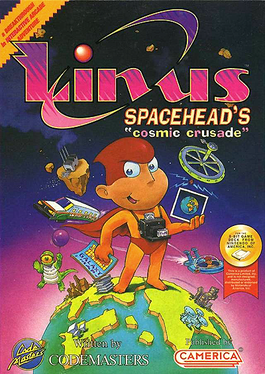
Linus Spacehead's Cosmic Crusade is a video game released in 1992 by Codemasters for the Nintendo Entertainment System. A remake of the game, retitled Cosmic Spacehead, was released in 1993 for Amiga, MS-DOS, Game Gear, Master System, and Genesis. The game features adventure elements, with locations connected by platform sections.

The Nintendo World Championships (NWC) is a nationwide video game competition series, organized by Nintendo of America at no particular interval.
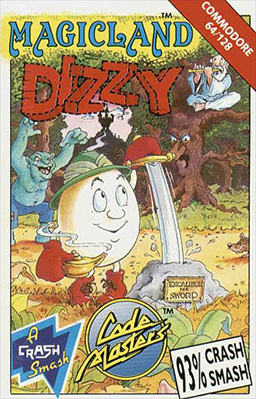
Magicland Dizzy is a platform adventure game published in Europe in 1990 by Codemasters for the ZX Spectrum, Commodore 64 and Amiga platforms. By 1992 there were also MS-DOS, Atari ST and Amstrad CPC versions available. It is the sixth game in the Dizzy series, and the fourth adventure-based Dizzy title. The story, set in a fantasy world called Magicland, follows on from the events of Fantasy World Dizzy, the previous adventure title. In Magicland Dizzy the player controls Dizzy, an egg-shaped character, who is trying to save six of his friends who have been placed under spells by the Evil Wizard Zaks.
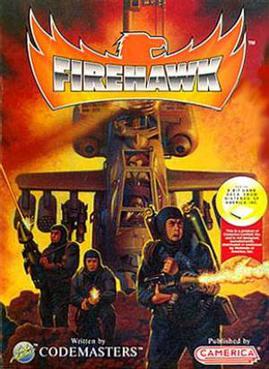
FireHawk is an unlicensed game developed by Codemasters which was released by Camerica for the Nintendo Entertainment System. This game has the player being commissioned by the President of the United States to stop the trafficking of drugs into the United States. The player flies an Apache helicopter to different places around the world and the player must destroy the drug traffickers' factories. It is very similar to Desert Strike and the rest of the "Strike" series, and nearly identical to Raid on Bungeling Bay, which was released for the Commodore 64 in 1984 as well as the Nintendo Entertainment System and MSX computers in 1985. On 1993, an unrelated action game Firehawk was shown by Sony.
Micro Machines is a series of video games featuring toy cars, developed by Codemasters and published on several platforms. The series is based on the Micro Machines toy line of miniature vehicles.

CJ's Elephant Antics is a platform game developed by Genesis for the Commodore 64 with conversions made for the Amiga, Atari ST, ZX Spectrum and Nintendo Entertainment System. All ports were handled by Genesis with the exception of the ZX Spectrum version which was handled by Big Red Software. The computer versions were published by Codemasters in 1991, with the NES game arriving in 1992 as part of the unlicensed compilation cartridge Quattro Arcade. The player controls a baby elephant by the name of Columbus Jumbo on his way home to Africa.

Lewis Galoob Toys, Inc. v. Nintendo of America, Inc. is a 1992 legal case where the United States Court of Appeals for the Ninth Circuit concluded that there was no copyright infringement made by the Game Genie, a video game accessory that could alter the output of games for the Nintendo Entertainment System. The court determined that Galoob's Game Genie did not violate Nintendo's exclusive right to make derivative works of their games, because the Game Genie did not create a new permanent work. The court also found that the alterations produced by the Game Genie qualified as non-commercial fair use, and none of the alterations were supplanting demand for Nintendo's games.

Rolan's Curse, known in Japan as Velious Roland no Majuu is an action adventure video game developed by Sammy and released for the Game Boy in 1990. Sammy released a follow up to Rolan's Curse for the Game Boy in 1992, entitled Rolan's Curse II.
Quattro is a series of video game compilations released in the 1990s. They consisted of games developed by Codemasters. The NES versions were released as multicarts and were published by Camerica without a license by Nintendo.

Castlevania, known in Japan as Akumajō Dracula, is a platform game developed and published by Konami for the Family Computer Disk System video game console in Japan in September 1986. It was ported to cartridge format and released in North America for the Nintendo Entertainment System (NES) in May 1987 and in Europe in 1988. It was also re-issued for the Family Computer in cartridge format in 1993. It is the first game in Konami's Castlevania video game series.

Micro Machines is a racing video game developed by Codemasters and originally published by Camerica for the Nintendo Entertainment System in 1991. Themed around Galoob's Micro Machines toys, players race in miniaturised toy vehicles around various environments. The game is the first installment in the Micro Machines video game series.
